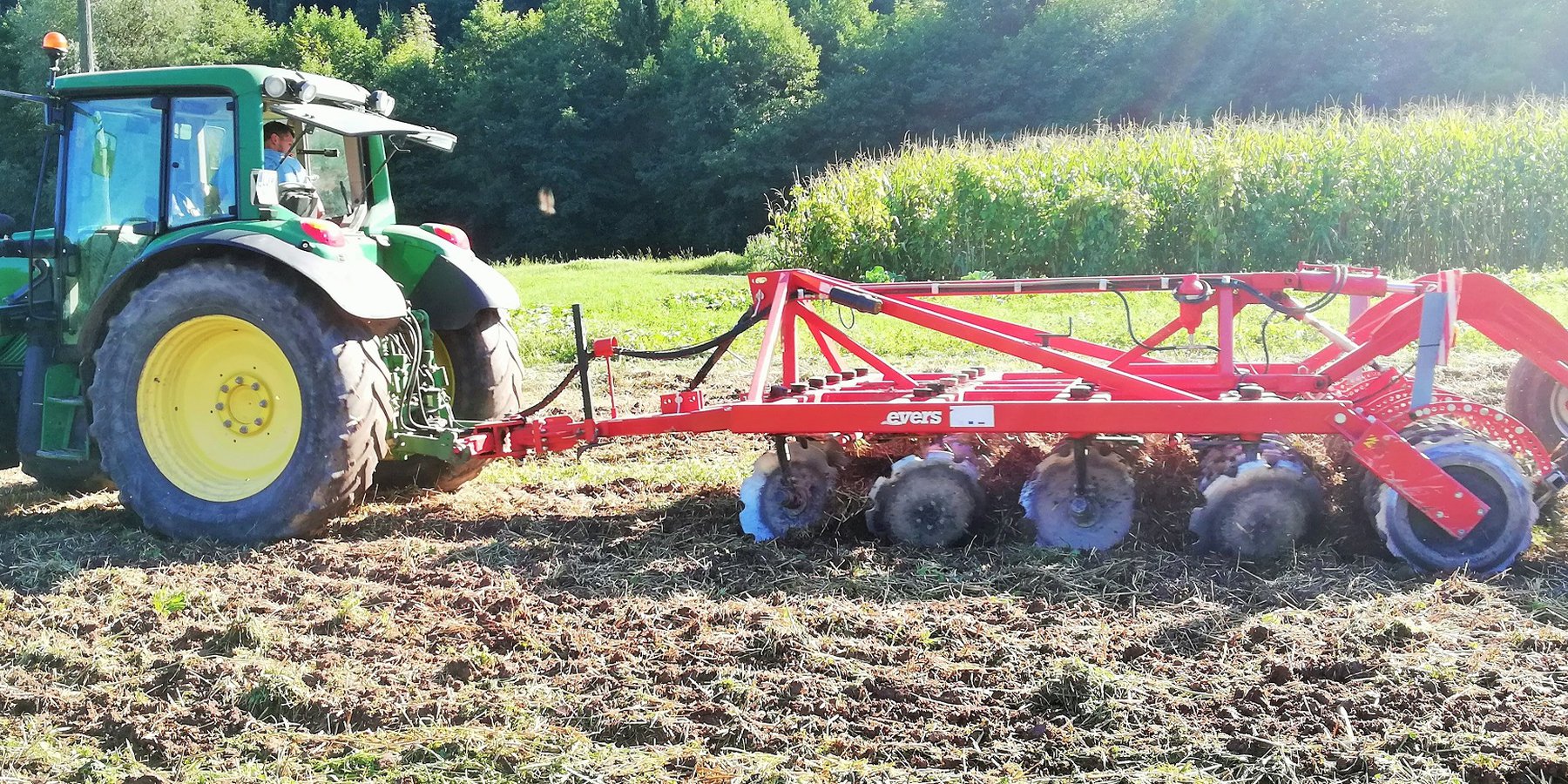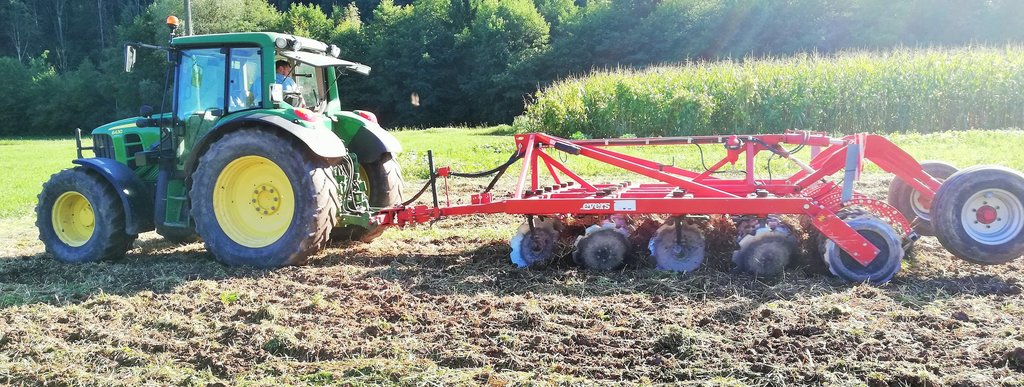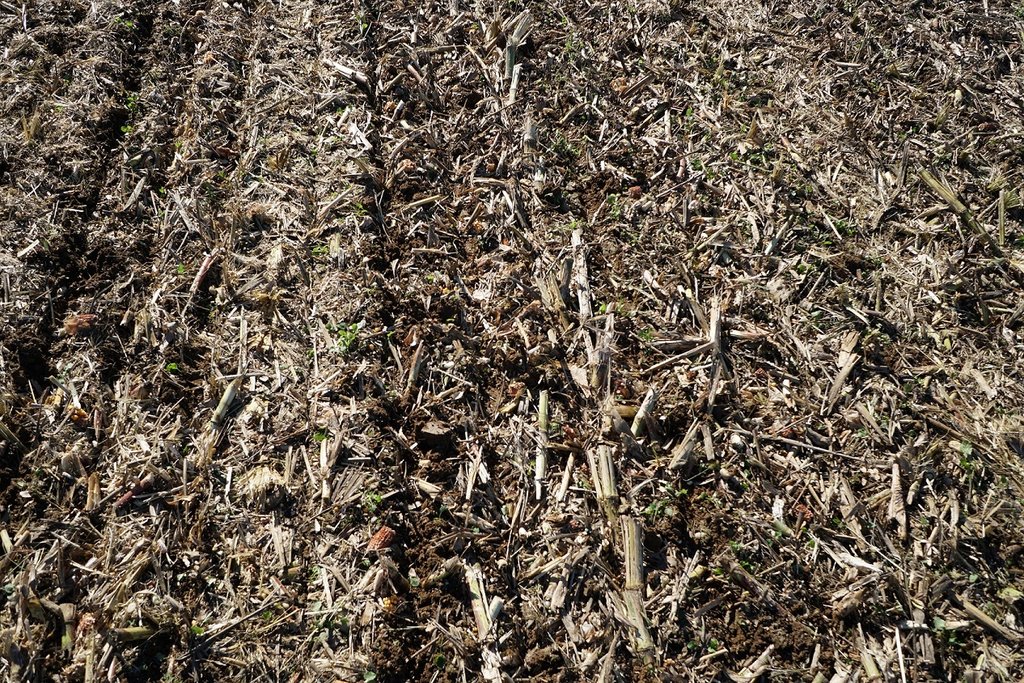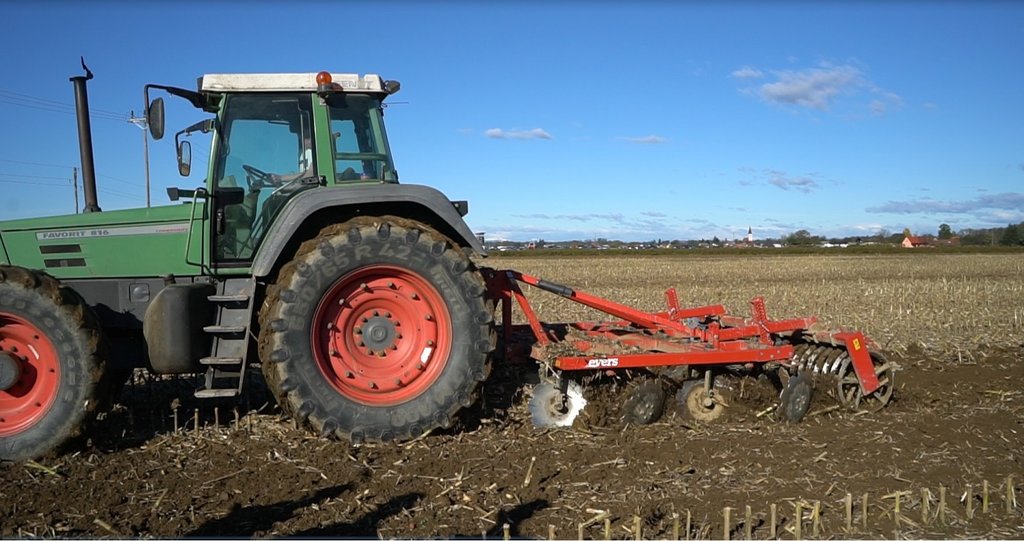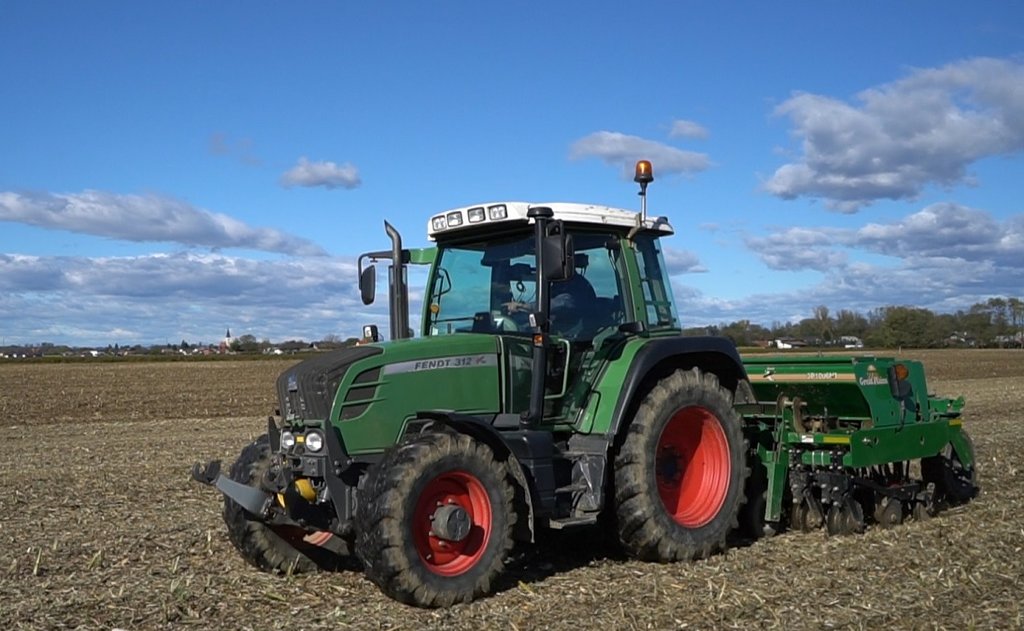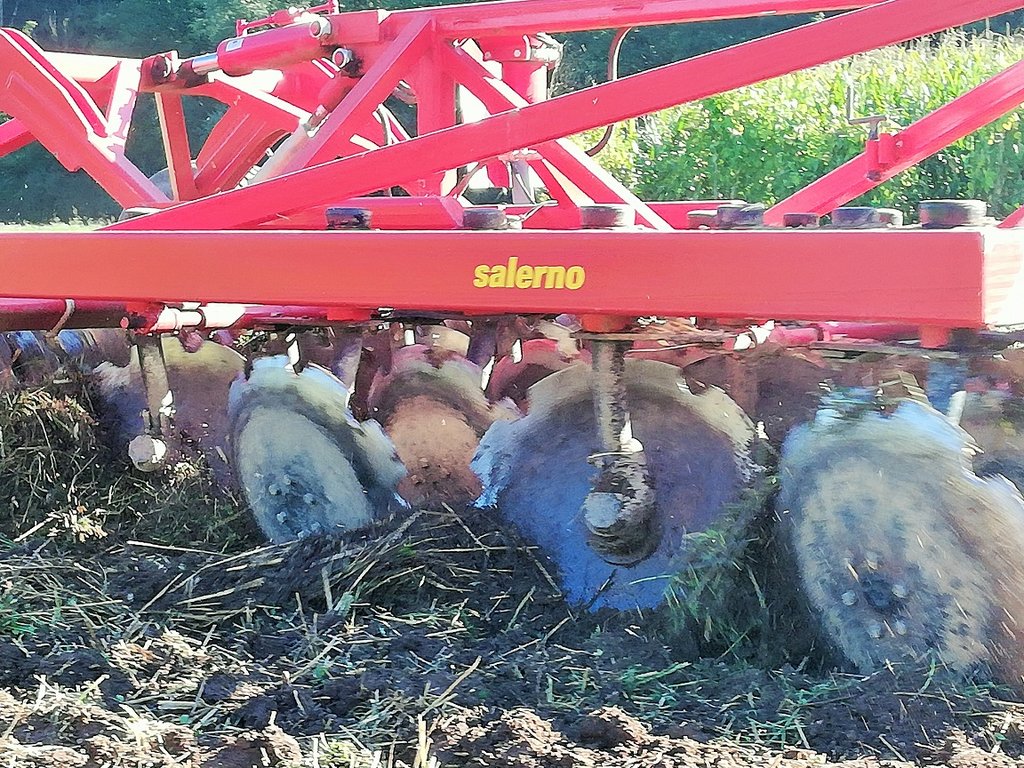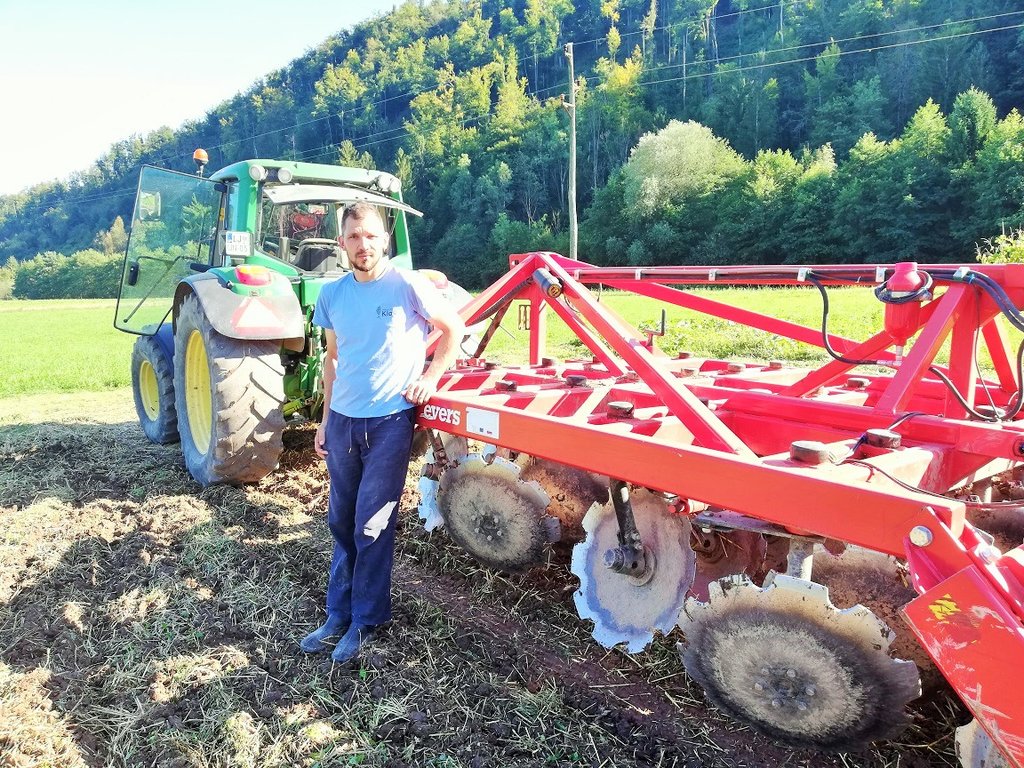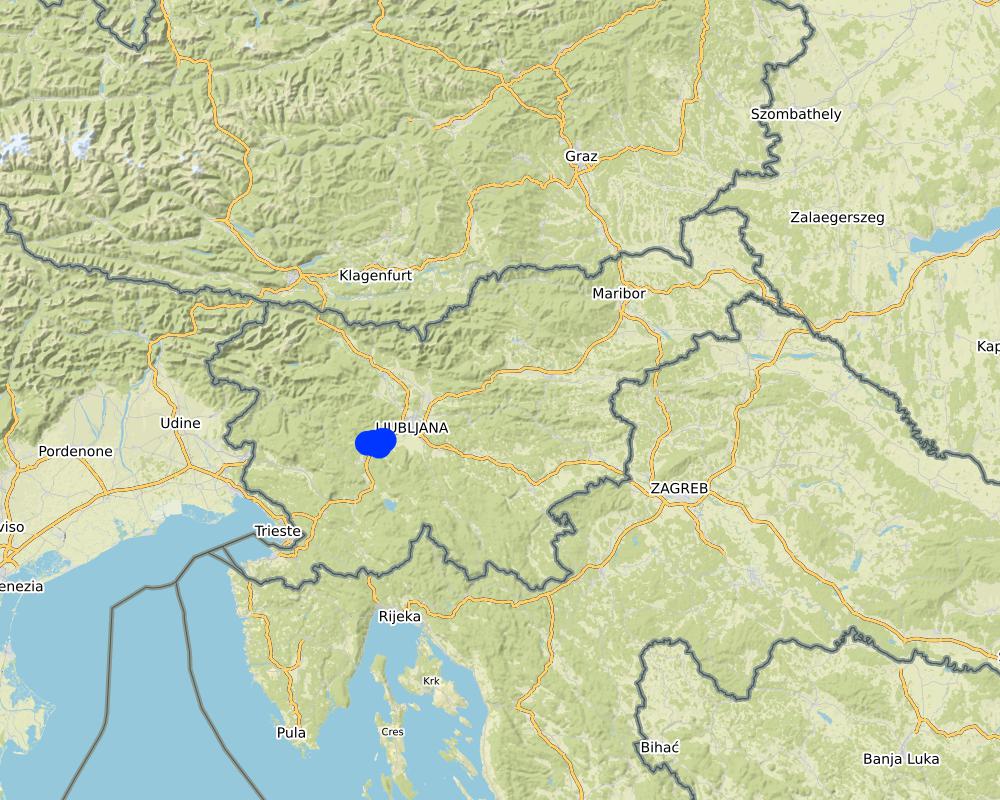Conservation tillage with incorporated mulched plant residues (mulch-till) [Eslovenia]
- Creación:
- Actualización:
- Compilador: Matjaz Glavan
- Editor: –
- Revisor: Rima Mekdaschi Studer
Ohranitvena obdelava tal z vdelavo mulčenih rastlinskih ostankov
technologies_5494 - Eslovenia
Visualizar secciones
Expandir todo Colapsar todos1. Información general
1.2 Detalles de contacto de las personas de referencia e instituciones involucradas en la evaluación y la documentación de la Tecnología
Persona(s) de referencia clave
usuario de la tierra:
Mrzlikar Anton
Family farm
Eslovenia
Nombre del proyecto que financió la documentación/ evaluación de la Tecnología (si fuera relevante)
Interactive Soil Quality assessment in Europe and China for Agricultural productivity and Environmental Resilience (EU-iSQAPER)Nombre de la(s) institución(es) que facilitaron la documentación/ evaluación de la Tecnología (si fuera relevante)
Department for Agronomy, University of Ljubljana - Eslovenia1.3 Condiciones referidas al uso de datos documentados mediante WOCAT
El compilador y la/s persona(s) de referencia claves aceptan las condiciones acerca del uso de los datos documentados mediante WOCAT:
Sí
1.4 Declaración de la sostenibilidad de la Tecnología descrita
¿La Tecnología aquí descrita resulta problemática en relación a la degradación de la tierra, de tal forma que no puede considerársela una tecnología sostenible para el manejo de la tierra?
No
2. Descripción de la Tecnología MST
2.1 Breve descripción de la Tecnología
Definición de la Tecnología:
Conservation tillage with incorporated mulched plant residues (mulch-till) of harvested crop or a green manure that are part of the rotation). Crop residues are partially incorporated/mixed in topsoil layer (down to 10 cm) using a disc harrow, chisel plough, sweeps, field cultivators, that leave more than 30% of the soil surface covered with crop residue. Technology contributes to less soil disturbance, increase of soil organic matter, better soil structure and better water holding capacity of soils.
2.2 Descripción detallada de la Tecnología
Descripción:
1. The technology of conservational tillage with incorporated mulched plant residues (mulch-till) is applied in flatlands around the Municipality of Vrhnika with an average altitude of 290 m.a.s.l. Average annual precipitation is 1400 mm. The area is characterized with often stormy precipitation events and occasional summer droughts. A farmer applies this technology on various soil types from silty loam to silty clay Gleysol to organic Histosol soils (peat). Soils in the area are generally moderately deep to deep with medium soil organic matter (Gleysol) of 3-7% or with a high share of organic matter (Histosol) of >20% (Ljubljana moors). The area has good availability of surface water and groundwater of good drinking quality. Gleysol areas are drained (drainage systems) to prevent floods to enable cultivation. Histosol areas are drained (open-channel drainage systems) to enable arable crop production. However, due to high groundwater and many surface water sources, certain areas are regularly flooded during flood events mostly in late autumn, winter and spring. Salinity is not a problem due to high precipitation and leaching. Farmer practices rotational agriculture. Less than 5% of income coming from off-farm activities. The examined farm household has an average wealth and is fully mechanized/motorized. the farm has good access to services and infrastructure. The examined farm is medium in scale with land partly owned by the land user and partly leased from other private owners.The general biodiversity of the area is medium on Gleysols to high on Histosol where nature protection Landscape Park of Ljubljansko Barje (The Ljubljana Moors Landscape Park) is located.
Part of the farmers land parcels is located inside boundaries of Krajinski park Ljubljansko barje /Ljubljana Moor Landscape park. Park takes a lot of actions to secure peat soils. This almost 16,000 hectares large lowland marshy plain is marked by an interminable mosaic of grasslands, broadleaf woodlands, fields, ditches and hedges.
The farmer decided to abandon conventional ploughing technology and to start with conservational tillage technology when he noticed that the organic layer of peat soils in these areas started to become thinner. Farmer introduced this technology to preserve peat soils of Ljubljana Moors on his parcels in 2015. With ploughing, peat was mixed and decomposing - mineralise. In 18th-century peat layers of up to 2m depth were exploited for the same use as firewood. Only shallow layers of peat soil (up to 1 m) are still covering agricultural areas. As peat is a source of fertility farmers are seeking ways of preserving it. Farmer Anton Mrzlikar took a lead and started with conservational tillage with incorporated mulched plant residues (mulch-till).
Video https://vimeo.com/97415985 presents the effects of conservational tillage with incorporated mulched plant residues (mulch-till) on soil stability. This is a simulation of abundant summer rain and its impact on the tilled soils in terms of water infiltration capacity and erodibility. The result of this simulation is presented very clearly. It shows the difference between long-term conventional versus conservation tillage (mulch-till). Conventional tillage ploughs the top 25-28 cm of the soil at least once or twice a year. The soil is inverted, its structure breaks down and the surface is left bare. The first raindrops break the structural aggregates causing soil surface siltation and blockage of the soil pores. Thus vertical water flow is blocked and redirected as surface runoff, causing distinct erosion. If fertilizers and pesticides are used, the water flow will transport them, along with the soil particles, to surface waters where they cause pollution or surface ponding on the fields. This leads to an uneven distribution of substances across the field surface.
In conservation tillage (mulch-till), a shallow, 10 cm layer of topsoil is mixed with organic residues which are thus retained near and on the surface. In this way, soil structure is reinforced with good soil water infiltration and absorption. Despite heavy rainfall, the soils do not show any signs of erosion. There is no surface flow. Water drains into the soil vertical flow where it is available to the plants.
2. The farmer usees of 4-row-disk harrow tillage machinery (vario-disc) on arable fields for all crop types. When cultivating fields he crosses fields 1 - 2 times (depends on soil moisture). Every few years he uses chisels to break and shatters (aerate) the soils (depends on crop type - cereals and drought years). After main/first crop he seeds various cover crops (if fodder is needed they harvested it otherwise is used for green manure). He uses manure 30-40 t/ha. He applies typical dairy cow farm rotation (cereals/maize/soya/grass-clover mix). Cover crops are classified as rapes, cereals, oats, grass-clover, grass.
3. The main function is an increase of organic matter, retain water, increase soil biodiversity, stabilise soil structure in the soils and reduce water erosion, as well as reduce energy consumption and costs. This leads to better (1) productivity due to nutrients slow-release, (2) better water holding capacity and (3) decreased soil compaction threat. The technology was introduced to prevent decomposition of organic matter on Ljubljana moor peat soils.
4. Major inputs needed to establish is to change machinery and to gain new knowledge and experiences. They had to buy 4-row disc harrows, chisels plough and new seeders (maize). Seeding machines for cereals and oilseed rape are hired from other farmers. It is important that soils are covered all year round. Soils must be dry when cultivated.
5. The benefits are (1) increase in soil organic matter, (2) increase soil water holding capacity, (3) to maintain soil productivity, (4) increase in yields quantity and quality, (5) reduce energy consumption, (6) reduce workload - 3-4 times less time used for cultivation, (7) reduce costs.
6. Land users like (1) reduced workload and energy consumption, (2) positive impact on soil fertility and stability, (3) preserves organic matter - decrease peat soils decomposition, (4) as soils need to be covered all the time they produce more feed for cows, (5) smooths surface fields, (6) with disc harrow is easy to till soils even when residues are present on fields, (7) less soil compaction
Land users dislike: (1) investment cost for new machinery are high, (2) time to change in doing things and practice, (3) on clay soils (Gleysol) surface ponding is occurring, (4) soils need to be drier for tilling in comparison to ploughing.
2.3 Fotografías de la Tecnología
2.4 Videos de la Tecnología
Comentarios, descripción breve:
This is a simulation of abundant summer rain and its impact on the tilled soils in terms of water infiltration capacity and erodibility. The result of this simulation is presented very clearly. It shows the difference between long-term conventional versus conservation soil tillage.
Conventional tillage ploughs the top 25-28 cm of the soil at least once or twice a year. The soil is inverted, its structure breaks down and the surface is left bare. The first raindrops break the structural aggregates causing soil surface siltation and blockage of the soil pores. Thus vertical water flow is blocked and redirected as surface runoff, causing distinct erosion. If fertilizers and pesticides are used, the water flow will transport them, along with the soil particles, to surface waters where they cause pollution or surface ponding on the fields. This leads to an uneven distribution of substances across the field surface.
In conservation tillage (mulch-till), a shallow, 10 cm layer of topsoil is mixed with organic residues which are thus retained near and on the surface. In this way, soil structure is reinforced with good soil water infiltration and absorption. Despite heavy rainfall, the soils do not show any signs of erosion. There is no surface flow. Water drains into the soil vertical flow where it is available to the plants.
Fecha:
04/12/2017
Lugar:
Ljubljana, Biotechnical Faculty, University of LJubljana
Nombre del videógrafo:
Rok Mihelič, Marko Zupan, Matjaž Glavan - Agronomy Department, Biotechnical Faculty, University of Ljubljana
Comentarios, descripción breve:
Presenting 4-row disch harrow in action.
Fecha:
12/04/2017
Lugar:
Slovenia
Nombre del videógrafo:
Rok Mihelič, Agronomy Department, Biotechnical Faculty, University of Ljubljana
Comentarios, descripción breve:
Presening seeder (cereals/oilseed rape) in action and condition of soil surface after tillage and seeding.
Fecha:
12/04/2017
Lugar:
Slovenia
Nombre del videógrafo:
Rok Mihelič, Agronomy Department, Biotechnical Faculty, University of Ljubljana
2.5 País/ región/ lugares donde la Tecnología fue aplicada y que se hallan comprendidos por esta evaluación
País:
Eslovenia
Región/ Estado/ Provincia:
Central Slovenia
Especifique más el lugar :
Podlipa, Vrhnika. This specific farmer applies this technology on Ljubljansko barje, othewise is applied all over Slovenia
Especifique la difusión de la Tecnología:
- aplicada en puntos específicos/ concentrada en un área pequeña
¿El/los sitio(s) de la Tecnología se ubica(n) en un área de protección permanente?
Sí
Si fuera el caso, especifique :
Part of his land parcels is located inside boundaries of Krajinski park Ljubljansko barje /Ljubljana Moor Landscape park. Park takes a lot of actions to secure peat soils. This almost 16,000 hectares large marshy plain is marked by an interminable mosaic of grasslands, broadleaf woodlands, fields, ditches and hedges.
http://www.ljubljanskobarje.si/?lang=en
Map
×2.6 Fecha de la implementación
Indique año de implementación:
2015
Si no se conoce el año preciso, indique la fecha aproximada:
- hace menos de 10 años (recientemente)
2.7 Introducción de la Tecnología
Especifique cómo se introdujo la Tecnología:
- mediante la innovación de usuarios de tierras
Comentarios (tipo de proyecto, etc.):
Farmer introduced this technology to preserve peat soils of Ljubljana Moors on his parcels in 2015. With ploughing, peat was mixed and decomposing - mineralise. In 18th-century peat layers of up to 2m depth were exploited for the same use as firewood. Only shallow layers of peat soil (up to 1 m) are still covering agricultural areas. As peat is a source of fertility farmers are seeking ways of preserving it. Farmer Anton Mrzlikar took a lead and started with mulch-till.
3. Clasificación de la Tecnología MST
3.1 Propósito(s) principal(es) de la Tecnología MST
- reducir, prevenir, restaurar la degradación del suelo
- adaptarse al cambio climático/ extremos climáticos y sus impactos
- crear impacto económico benéfico
3.2 Tipo(s) actuales de uso de la tierra donde se aplica la Tecnología
Mezcla de tipos de uso de tierras dentro de la misma unidad de tierras: :
No

Tierras cultivadas
- Cosecha anual
Cosechas anuales - Especifique cultivos:
- cereales - maíz
- cereals - maize - legumes - grass-clover mix
Sistema anual de cultivo:
Maíz o rotación similar con heno/pastizal
Número de temporadas de cultivo por año:
- 1
¿Se practica el intercultivo?
No
¿Se practica la rotación de cultivos?
Sí
Si fuera el caso, especifique :
cereals/maize/soy/grass-clover mix, additionally cover crops after main crop (soil must be covered all year round
3.3 ¿Cambió el uso de tierras debido a la implementación de la Tecnología?
¿Cambió el uso de tierras debido a la implementación de la Tecnología?
- No (Continúe con la pregunta 3.4)
3.4 Provisión de agua
Provisión de agua para la tierra donde se aplica la Tecnología:
- de secano
3.5 Grupo MST al que pertenece la Tecnología
- perturbación mínima del suelo
3.6 Medidas MST que componen la Tecnología

medidas agronómicas
- A2: materia orgánica/ fertilidad del suelo
- A3: Tratamiento de superficie del suelo
A3: Diferencie sistemas de labranza:
A 3.2: Reduced tillage (> 30% soil cover)
3.7 Principales tipos de degradación del suelo encarados con la Tecnología

erosión de suelos por agua
- Wt: pérdida de capa arable/ erosión de la superficie

deterioro físico del suelo
- Pc: compactación
- Ps: hundimiento de suelos orgánicos, asentamiento del suelo
3.8 Prevención, reducción o restauración de la degradación del suelo
Especifique la meta de la Tecnología con relación a la degradación de la tierra:
- reducir la degradación del suelo
Comentarios:
It is impossible to prevent degradation in the form of peat soil mineralisation in agricultural soils.
4. Especificaciones técnicas, actividades de implementación, insumos y costos
4.1 Dibujo técnico de la Tecnología
4.2 Información general sobre el cálculo de insumos y costos
Especifique cómo se calcularon los costos e insumos:
- por área de Tecnología
Indique tamaño y unidad de área:
30 ha
otra / moneda nacional (especifique):
EUR
Si fuera relevante, indique la tasa de cambio de dólares americanos a la moneda local (ej. 1 U$ = 79.9 Reales Brasileros): 1 U$ =:
0,9
Indique el costo promedio del salario de trabajo contratado por día:
50 EUR
4.3 Actividades de establecimiento
| Actividad | Momento (estación) | |
|---|---|---|
| 1. | Preparation of fields: Leveling depressions, reconstruction of drainage channels, using chisels to loose, break and aerate soil in deeper layers | two year before implemenation, dry soil. |
| 2. | Purchase of 4-row disc harrow | 1st year |
| 3. | Purchase of seeder for maize | 1st year |
| 4. | Purchase of seeder for cover crops | 1st year |
| 5. | Hire seeder for cereals (wheat, barley) | 1st year |
| 6. | Home made chisel plow for loosening the soil | 2nd year |
| 7. | Purchase of spraying machine | 3rd year |
| 8. | Purchase of GPS navigation system | 3rd year |
Comentarios:
The agricultural technology activities are listed in chronological order. Rotation cycle takes 3 years
4.4 Costos e insumos necesarios para el establecimiento
| Especifique insumo | Unidad | Cantidad | Costos por unidad | Costos totales por insumo | % de los costos cubiertos por los usuarios de las tierras | |
|---|---|---|---|---|---|---|
| Equipo | chisel plow material (home made) | EUR/piece | 1,0 | 6500,0 | 6500,0 | 100,0 |
| Equipo | seeder fo cover crops | EUR/piece | 1,0 | 2500,0 | 2500,0 | 50,0 |
| Equipo | seeder for maize | EUR/piece | 1,0 | 7500,0 | 7500,0 | 50,0 |
| Equipo | 4-row disk harrow | EUR/piece | 1,0 | 23000,0 | 23000,0 | 50,0 |
| Equipo | sprayer | EUR/piece | 1,0 | 12,5 | 12,5 | 25,0 |
| Equipo | GPS navigation | EUR/piece | 1,0 | 2500,0 | 2500,0 | 100,0 |
| Equipo | hire seeder for cereals | EUR/ha | 15,0 | 50,0 | 750,0 | 100,0 |
| Costos totales para establecer la Tecnología | 42762,5 | |||||
| Costos totales para establecer la Tecnología en USD | 47513,89 | |||||
Si el usuario de la tierra no cubrió el 100% de los costos, indique quién financió el resto del costo:
50% - Agency for agricultural payments (EU funds); 25% - sharred among farmers
Comentarios:
Cost for hiring seeder is calculated for 15ha as cereals cover 15ha of arable land.
4.5 Actividades de establecimiento/ recurrentes
| Actividad | Momento/ frequencia | |
|---|---|---|
| 1. | Maintenance of 4-disc harrow | 6 time per year, before or after use of equipment |
| 2. | Maintenance of Spayer | before use nozzels check, after use cleaning |
| 3. | Maintenance of seeder for maize | before and after use |
| 4. | Maintenance of seeder for cover crops | before and after use |
4.6 Costos e insumos necesarios para actividades de mantenimiento/ recurrentes (por año)
| Especifique insumo | Unidad | Cantidad | Costos por unidad | Costos totales por insumo | % de los costos cubiertos por los usuarios de las tierras | |
|---|---|---|---|---|---|---|
| Mano de obra | Maintenance of 4-disc harrow | hour | 6,0 | 6,25 | 37,5 | 100,0 |
| Mano de obra | Maintenance of Spayer | hour | 6,0 | 6,25 | 37,5 | 100,0 |
| Mano de obra | Maintenance of seeder for maize | hour | 4,0 | 6,25 | 25,0 | 100,0 |
| Mano de obra | Maintenance of seeder for cover crops | hour | 1,0 | 6,25 | 6,25 | 100,0 |
| Equipo | Lubricant cartridge for4-disc harrow | cartridge | 18,0 | 5,0 | 90,0 | 100,0 |
| Equipo | Nozzels for Spayer | nozzel | 20,0 | 4,0 | 80,0 | 100,0 |
| Equipo | Lubricant cartridge for seeder for maize | cartridge | 4,0 | 5,0 | 20,0 | 100,0 |
| Equipo | Lubricant cartridge for seeder for cover crops | cartridge | 1,0 | 5,0 | 5,0 | 100,0 |
| Indique los costos totales para mantenecer la Tecnología | 301,25 | |||||
| Costos totales para mantener la Tecnología en USD | 334,72 | |||||
Comentarios:
There is a big difference between conventional and conservation tillage in time spend cultivating fields.
Farmer estimates reduction in workload (no ploughing) for 3-4 times in comparison to the conventional ploughing system.
Farmer points out an increase in green mass yield (clover, grass) due to cover crops which can be used as feed for livestock or green manure. He said that the most important part of this conservational system (mulch-till) is to prevent weeds to germinate, and that's why soil needs to be covered at all times.
He also states that top and subsoil layers are loose.
He states that he still uses the same amount of plant protection products.
The use of herbicides and fertilisers is at the same range as before the shift in practice, but he expects improvements in the future when he will further enhance knowledge on crop types, rotation and cover crops.
4.7 Factores más determinantes que afectan los costos:
Describa los factores más determinantes que afectan los costos:
The starting cost - The type of machinery is needed that has to be robust and heavy to much-till and seed into the soil.
The machinery must be in use to return a profit. Working hours are reduced now (no ploughing). Machine operators with more competences can reduce costs.
5. Entorno natural y humano
5.1 Clima
Lluvia anual
- < 250 mm
- 251-500 mm
- 501-750 mm
- 751-1,000 mm
- 1,001-1,500 mm
- 1,501-2,000 mm
- 2,001-3,000 mm
- 3,001-4,000 mm
- > 4,000 mm
Zona agroclimática
- húmeda
Heavy summer thunderstorms and showers. Local precipitation.
5.2 Topografía
Pendientes en promedio:
- plana (0-2 %)
- ligera (3-5%)
- moderada (6-10%)
- ondulada (11-15%)
- accidentada (16-30%)
- empinada (31-60%)
- muy empinada (>60%)
Formaciones telúricas:
- meseta/ planicies
- cordilleras
- laderas montañosas
- laderas de cerro
- pies de monte
- fondo del valle
Zona altitudinal:
- 0-100 m s.n.m.
- 101-500 m s.n.m.
- 501-1,000 m s.n.m
- 1,001-1,500 m s.n.m
- 1,501-2,000 m s.n.m
- 2,001-2,500 m s.n.m
- 2,501-3,000 m s.n.m
- 3,001-4,000 m s.n.m
- > 4,000 m s.n.m
Indique si la Tecnología se aplica específicamente en:
- no relevante
5.3 Suelos
Profundidad promedio del suelo:
- muy superficial (0-20 cm)
- superficial (21-50 cm)
- moderadamente profunda (51-80 cm)
- profunda (81-120 cm)
- muy profunda (>120 cm)
Textura del suelo (capa arable):
- fina/ pesada (arcilla)
Textura del suelo (> 20 cm debajo de la superficie):
- fina/ pesada (arcilla)
Materia orgánica de capa arable:
- elevada (>3%)
Si se halla disponible, adjunte una descripción completa de los suelos o especifique la información disponible, por ej., tipo de suelo, pH/ acidez de suelo, capacidad de intercambio catiónico, nitrógeno, salinidad, etc. :
Organic matter on Gleysol is around 6% and on Histosol (peatland) more than 30%. Bellow the peatland is clay (called "polžarica", or "snail clay")
5.4 Disponibilidad y calidad de agua
Agua subterránea:
< 5 m
Disponibilidad de aguas superficiales:
bueno
Calidad de agua (sin tratar):
solo para uso agrícola (irrigación)
La calidad de agua se refiere a:
agua superficial
¿La salinidad del agua es un problema?
No
¿Se está llevando a cabo la inundación del área? :
Sí
Frecuencia:
frecuentemente
Comentarios y especificaciones adicionales sobre calidad y cantidad de agua:
On Ljubljana moor, seasonal floods are occurring regularly due to the high water table.
5.5 Biodiversidad
Diversidad de especies:
- elevada
Diversidad de hábitats:
- elevada
Comentarios y especificaciones adicionales sobre biodiversidad:
This true especially for the Ljubljana moor.
5.6 Las características de los usuarios de la tierra que aplican la Tecnología
Sedentario o nómada:
- Sedentario
Orientación del mercado del sistema de producción:
- comercial/ mercado
Ingresos no agrarios:
- menos del 10% de todos los ingresos
Nivel relativo de riqueza:
- promedio
Individuos o grupos:
- individual/ doméstico
Nivel de mecanización:
- mecanizado/motorizado
Género:
- mujeres
- hombres
Edad de los usuarios de la tierra:
- niños
- personas de mediana edad
- ancianos
5.7 Área promedio de la tierra usada por usuarios de tierra que aplican la Tecnología
- < 0.5 ha
- 0.5-1 ha
- 1-2 ha
- 2-5 ha
- 5-15 ha
- 15-50 ha
- 50-100 ha
- 100-500 ha
- 500-1,000 ha
- 1,000-10,000 ha
- > 10,000 ha
¿Esto se considera de pequeña, mediana o gran escala (refiriéndose al contexto local)?
- escala mediana
Comentarios:
83 ha of agricultural land and 7 ha of forest
5.8 Tenencia de tierra, uso de tierra y derechos de uso de agua
Tenencia de tierra:
- individual, con título
Derechos de uso de tierra:
- arrendamiento
- individual
Derechos de uso de agua:
- individual
¿Los derechos del uso de la tierra se basan en un sistema legal tradicional?
Sí
Comentarios:
2/3 of land is hired from The Farmland and Forest Fund of the Republic of Slovenia
5.9 Acceso a servicios e infraestructura
salud:
- pobre
- moderado
- bueno
educación:
- pobre
- moderado
- bueno
asistencia técnica:
- pobre
- moderado
- bueno
empleo (ej. fuera de la granja):
- pobre
- moderado
- bueno
mercados:
- pobre
- moderado
- bueno
energía:
- pobre
- moderado
- bueno
caminos y transporte:
- pobre
- moderado
- bueno
agua potable y saneamiento:
- pobre
- moderado
- bueno
servicios financieros:
- pobre
- moderado
- bueno
6. Impactos y comentarios para concluir
6.1 Impactos in situ demostrados por la Tecnología
Impactos socioeconómicos
Producción
producción de cultivo
calidad de cultivo
producción de forraje
Comentarios/ especifique:
It increased due to the fact that soil has to be covered at all times (grass, clover, cover crops) to retain soil moisture and prevent soil erosion and to provide an optimal living condition for soil life (fauna, flora). Previously the land was left bare after harvesting cereals until autumn or even spring.
calidad de forraje
producción animal
Comentarios/ especifique:
Due to more fodder, the farmer managed to increase the number of livestock (dairy cows).
riesgo de fracaso de producción
Comentarios/ especifique:
Due to the fact that soils are not ploughed anymore, a farmer has in wet years (more precipitation in a short period of time, especially in the springtime) problems on organic marshland and clay gley soils being fully saturated. This causes a reduction in the germination of seeds and weaker growth of plants due to hypoxia.
diversidad de producto
Comentarios/ especifique:
More different types of cover crops in production. Some are used as nitrogen fixators or for loosening the soils with deep rots.
manejo de tierras
Comentarios/ especifique:
The land management simplified due to fewer machines needed and less time need for land cultivation and soil preparation.
Ingreso y costos
gastos en insumos agrícolas
Comentarios/ especifique:
Less petrol nedeed for land cultivation.
ingreso agrario
Comentarios/ especifique:
More livestock means more income.
carga de trabajo
Comentarios/ especifique:
Workload decreased due to abandoning of ploughing.
Impactos socioculturales
MST/ conocimiento de la degradación del suelo
Comentarios/ especifique:
The farmer observed positive impacts and seeks for more knowledge on this topic to improve its practice.
Impactos ecológicos
Ciclo de agua/ escurrimiento de sedimento
escurrimiento superficial
evaporación
Suelo
humedad del suelo
cubierta del suelo
pérdida de suelo
encostramiento/ sellado de suelo
compactación de suelo
ciclo/ recarga de nutrientes
materia orgánica debajo del suelo C
Biodiversidad: vegetación, animales
Cubierta vegetal
biomasa/ sobre suelo C
Reducción de riesgos de desastres y riesgos climáticos
impactos de sequías
emisión de carbono y gases de invernadero
Comentarios/ especifique:
Difficult to quantify. An increase in soil organic matter has an impact on CO2 sequestration.
6.3 Exposición y sensibilidad de la Tecnología al cambio climático gradual y a extremos relacionados al clima/ desastres (desde la percepción de los usuarios de tierras)
Cambio climático gradual
Cambio climático gradual
| Estación | Incremento o reducción | ¿Cómo es que la tecnología soporta esto? | |
|---|---|---|---|
| temperatura anual | incrementó | bien | |
| temperatura estacional | verano | incrementó | bien |
| lluvia anual | bien | ||
| lluvia estacional | primavera | incrementó | moderadamente |
Extremos (desastres) relacionados al clima
Desastres climatológicos
| ¿Cómo es que la tecnología soporta esto? | |
|---|---|
| ola de calor | bien |
| sequía | bien |
6.4 Análisis costo-beneficio
¿Cómo se comparan los beneficios con los costos de establecimiento (desde la perspectiva de los usuarios de tierra)?
Ingresos a corto plazo:
ligeramente negativo
Ingresos a largo plazo:
positivo
¿Cómo se comparan los beneficios con los costos de mantenimiento/ recurrentes (desde la perspectiva de los usuarios de tierra)?
Ingresos a corto plazo:
ligeramente positivo
Ingresos a largo plazo:
positivo
Comentarios:
Benefits are on short term slightly negative due to investment costs, but in the long term they are positive - they pay off.
Maintenance benefits are positive for short as well as on long-term returns as less machinery and less land management activities is needed.
6.5 Adopción de la Tecnología
- casos individuales / experimentales
Si tiene la información disponible, cuantifique (número de hogares y/o área cubierta):
Only one farmer in the area that uses this technology. On the map you can observe his fields. In the last year many of his collegues observed advantages of this technology and hires his machinery as agriculture service of tillage. In majority of times before cover crops seeding.
6.6 Adaptación
¿La tecnología fue modificada recientemente para adaptarse a las condiciones cambiantes?
No
6.7 Fuerzas/ ventajas/ oportunidades de la Tecnología
| Fuerzas/ ventajas/ oportunidades desde la perspectiva del usuario de la tierra |
|---|
| Reduction of workload (no ploughing, less time spent on the field) |
|
Change in farmers mindset is longlasting; they are forced to gain new knowledge on technology impact on soil condition With more knowledge and better handling of technology, the cost of maintenance and time spent in the field can reduce significantly. |
|
Increase in green mass yield (clover, grass) - it can be used as feed for livestock or green manure. Soil covered all year round + residues impact increase in soil organic matter, soil water content, biological activity, soil structure, less soil compaction. |
| Fuerzas/ ventajas/ oportunidades desde la perspectiva del compilador o de otra persona de referencia clave |
|---|
| Cost and time reductions are substantial - 3-4 times less in comparsio to conventional - ploughing. |
|
Farmers became aware of the importance of conservation soil management and its impact on soil properties and finally on the process of production-chain (soil-feed-milk). With proper shaping of knowledge (advising, education) - Conservational tillage has the potential to develop into the direction of organic farming. |
| Soil structure and fertility improve |
6.8 Debilidades/ desventajas/ riesgos de la Tecnología y formas de sobreponerse a ellos
| Debilidades/ desventajas/ riesgos desde la perspectiva del usuario de la tierra | ¿Cómo sobreponerse a ellas? |
|---|---|
| On heavy soils (Glaysoils) surface ponding can occur if the farmer is not experienced with using technology. | Observe weather regularly and follow meteorological forecasts. Try to avoid wet periods. |
| Weed may be a problem in the warmer part of the year, mainly after cereals are harvested. | They use herbicide and adapt or improve crop types in rotation. |
| Peatland on Ljubljana moor. There are small parcels and soil in springtime is wet prohibiting to cultivate at any time (high water table). | Observe weather regularly and follow meteorological forecasts. They have to observe soil water content conditions periodically at peatland parcels. |
| Debilidades/ desventajas/ riesgos desde la perspectiva del compilador o de otra persona de referencia clave | ¿Cómo sobreponerse a ellas? |
|---|---|
| Farmers still need to use herbicides as weeds are a problem especially in the early stage of crop growing (narrow-leaf) and in the last stage when crops go into senescence and light gets to the ground (broad-leaf). |
As this is a conventional type of farm, they use herbicides. However, with the promotion of organic agriculture, the expansion of vegetable production, and innovations in GPS and sensors technology hoeing/weeding machines/equipment is getting popular. This problem is even more problematic in light/alluvial soils. |
| Surface ponding on heavy soils is a problem in case of longlasting rain periods in spring, which are due to climate change more often in the described area. |
It is crucial to use chisel plow in this soils to break soil layers deeper and provide drainage potential of this soils. In light alluvial soils, this problem is not observed. |
| When a farmer in under Slovenian agricultural conditions decides to change from conventional to conservation tillage, it has to change all machinery. | Farmers need to get as much as possible information on technology. Farmers have to make a business plan. EU funds can help with subsidy payments for investments on the farm (approx. 50-60%). |
7. Referencias y vínculos
7.1 Métodos/ fuentes de información
- visitas de campo, encuestas de campo
1 farmer
- entrevistas con usuarios de tierras
1 farmer
- entrevistas con especialistas/ expertos en MST
1 specialist
¿Cuándo se compilaron los datos (en el campo)?
10/05/2019
7.3 Vínculos a la información relevante disponible en línea
Título/ descripción:
OHRANITVENA OBDELAVA TAL –STANJE V SLOVENIJI
URL:
http://www.digitalna-knjiznica.bf.uni-lj.si/du1_ograjsek_simon.pdf
Título/ descripción:
Izzivi uvajanja konzervirajoče (ohranitvene) obdelave tal
URL:
http://www.kmetzav-mb.si/Lombergar_18/Lomb_5_2_18.pdf
Título/ descripción:
NOVE TEHNOLOGIJE IN SODOBNI TRENDI OBDELOVANJA TAL
URL:
http://www.kgzs-ms.si/wp-content/uploads/2018/04/STAJNKO_NOVE-TEHNOLOGIJE.pdf
Título/ descripción:
Ohranitvena obdelava : primerjava lastnosti mehansko obdelanih in neobdelanih prsti
URL:
https://www.dlib.si/details/URN:NBN:SI:DOC-LTCNTC4J
Título/ descripción:
SZOORT - Slovensko združenje za ohranitveno obdelavo in rodovitnost tal
URL:
http://www.szoort.si/
Título/ descripción:
Ohranitveni način obdelave tal
URL:
https://www.program-podezelja.si/sl/247-eup/izmenjevalnik-idej/seznam-izzivov/759-ohranitveni-obdelave-tal
Vínculos y módulos
Expandir todo Colapsar todosVínculos
No hay vínculos
Módulos
No se hallaron módulos


